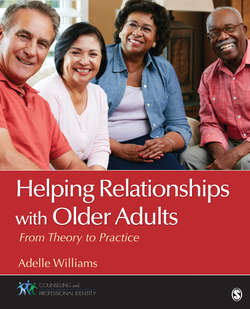Читать книгу Helping Relationships With Older Adults - Adelle M. Williams - Страница 34
На сайте Литреса книга снята с продажи.
Cardiovascular System
ОглавлениеIssues related to the cardiovascular system in older adults may negatively impact their psychological well-being. They may become depressed and anxious if they have been diagnosed with any accompanied heart disorders (e.g., angina, congestive heart failure, high blood pressure). The heart works harder due to medications, emotional stress, physical exertion, illness, infections and injuries (Hurd, 2014). These factors might interfere with daily activities, engaging in social relationships and activities, employment and a host of routine activities that bring meaning to the lives of older persons. Mental health professionals are in a position to educate their older clients on their condition and the impact it has had on their lives, provide support in their adjustment to their condition, and empower them to make decisions that will support a healthy lifestyle. Mental health professionals will need to encourage their older clients to eat a heart-healthy diet, encourage physical exercise, maintain appointments with health care providers, and comply with their identified treatment regimen as prescribed by their primary care physician. Mental health practitioners will need to address the cardiovascular issues as they impact daily activities and be certain to conduct sessions with the older patient and available family members. Encouraging family support or initiating new supports is essential in this treatment process.
Changes and diseases associated with the cardiovascular system can be attributed to aging, genetics, and also lifestyle choices. The cardiovascular system is responsible for having the heart pump an adequate amount of blood to the cells throughout the body. Aging, however, limits the heart’s functionality (Whitbourne, 2010). The heart has more difficulty pumping out blood so, in older adults, strenuous activities can become problematic at times. It is difficult to pinpoint the exact cause of the decline in functionality because major studies are not able to control the amount of a person’s physical activity throughout their life as well as other lifestyle choices such as drinking and smoking that have profound effects on the system (Whitbourne, 2010). For example, disease rates in older adults are significantly higher for people who smoke. Studies also show that change in body compositions in seniors are probably caused both by the process of aging and those external factors like physical inactivity (Weber, 2010).
A person’s age cannot be accurately defined by examining a heart; however, studies show a strong correlation between a person’s age and an increase in coronary artery disease (Arking, 2006). This is a severe problem because about half of the elderly population shows symptoms of cardiovascular disease, which is the leading cause of death. There is approximately a 30% increase in the thickness of the left ventricle wall among older adults (Arking, 2006).
Some of the problems associated with the cardiovascular system result from the loss in mass of muscle cells within the heart due to aging (Whitbourne, 2000). The left ventricle wall becomes thicker because of an increase in fat and connective tissue buildup caused by muscle mass decreasing. This makes the heart produce fewer functional contractions that pump the blood. During the diastolic phase (relaxation and dilation of the ventricles), the heart muscle stretches and the ventricles fill up with blood. Pressure builds in the blood as it is released into the aorta. During a condition known as diastolic dysfunction, the capacity of the walls of the heart is decreased, which reduces and delays filling up the left ventricle with blood. This impairs blood flow to various arteries throughout the body.
Another problem for older adults is that the cardiac muscle becomes less responsive to neural stimulation (activation/energizing of a nerve). The “pacemaker” cells in the heart are responsible for starting each contraction but become less responsive as a person ages. In addition, the heart muscles become less flexible, and the buildup of plaque forms in the inner linings of the arteries. This causes the arteries to become narrower, impeding the flow of blood through them. There is a natural age-related change that stiffens and narrows these arteries called vasculopathology of aging. The walls of the aorta are less flexible, which causes resistance for blood trying to travel far into the arteries. The main way to stave off these various cardiovascular problems is a healthy diet with exercise (Whitbourne, 2000). The purpose of Guided Practice Exercise 1.2 is to provide the opportunity to view the aging process from the perspective of an older family member.
Guided Practice Exercise 1.2
Interview your grandparent or other older adult in your family and inquire regarding the changes they noticed as they aged. Ask them how they felt regarding the changes and how they adjusted to them. Share this information with peers and colleagues.
